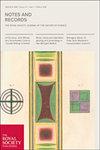欧洲催眠术的历史和地方意义。
IF 0.4
3区 哲学
Q3 HISTORY & PHILOSOPHY OF SCIENCE
Notes and Records-The Royal Society Journal of the History of Science
Pub Date : 2017-06-20
DOI:10.1098/rsnr.2017.0011
引用次数: 0
摘要
本文章由计算机程序翻译,如有差异,请以英文原文为准。
History of hypnotism in Europe and the significance of place.
Since the 1990s a number of studies, such as Alan Gauld's A history of hypnotism , Alison Winter's Mesmerized , Daniel Pick's Svengali's web , Andreas Mayer's Sites of the unconscious and, most recently, William Hughes' That devil's trick , have elucidated the scientific as well as the popular cultures in which mesmeric and hypnotic practices thrived in the nineteenth century.1 By the end of the nineteenth century – that is, the time on which the articles of this special issue focus – hypnotism was a common topic of medical, legal and public debate in several European countries. The therapeutic potential of hypnotic suggestion was balanced against the dangers of a mental state that made the individual a seemingly powerless subject of the hypnotizer's will and commands. Risks to individual and collective mental health, of sexual abuse of hypnotized persons, and of criminal suggestions were widely invoked whenever hypnotism was discussed. The ‘magnetic’ treatments by lay healers and the popular performances by stage hypnotists such as Donato (Alfred Edouard D'Hont) and Carl Hansen, who toured Europe, caused political concerns about public health and public order, leading to calls for the banning of hypnotic practices or for restricting their use to qualified medical men. Indeed, hypnotism appears to have been a practice around which a number of acute popular anxieties coalesced during the nineteenth century, including fears related to psychological contagion, crowds, race, class and gender.2
In the scientific discourse, the pendulum of opinion had begun to swing from Jean-Martin Charcot's school at the Salpetriere Hospital in Paris, which interpreted hypnosis as an induced pathological state of the nervous system, to Hippolyte Bernheim's school at the University of Nancy, which saw it as a psychological state resulting from suggestion. In some instances, however, the idea of pathology was hard …
求助全文
通过发布文献求助,成功后即可免费获取论文全文。
去求助
来源期刊
CiteScore
1.50
自引率
0.00%
发文量
45
审稿时长
>12 weeks
期刊介绍:
Notes and Records is an international journal which publishes original research in the history of science, technology and medicine.
In addition to publishing peer-reviewed research articles in all areas of the history of science, technology and medicine, Notes and Records welcomes other forms of contribution including: research notes elucidating recent archival discoveries (in the collections of the Royal Society and elsewhere); news of research projects and online and other resources of interest to historians; essay reviews, on material relating primarily to the history of the Royal Society; and recollections or autobiographical accounts written by Fellows and others recording important moments in science from the recent past.

 求助内容:
求助内容: 应助结果提醒方式:
应助结果提醒方式:


